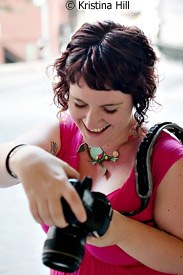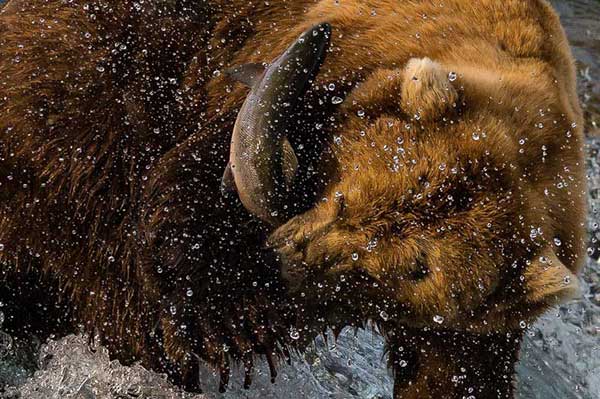
First, let's take a little trip back in time. When I began in the 1950's, photography was still largely a black & white medium, especially in the realm of photojournalism. Magazines were beginning to use color but the slow film speeds generally precluded its use for news stories. A few newspapers experimented with color, usually on the front or back page of the first section, but that was it. As for available light images, this was the heyday of the big picture magazines, like Life, and photos that had a natural look and were lit by the existing illumination (rather than with flash) were the norm. 35mm cameras (rangefinder models, not SLRs) loaded with fast film like Tri-X and equipped with fast lenses made all this possible. Newspapers, on the other hand, were still stuck with the old flash-in-the-face style of imaging. Part of the reason was the limitation of newspaper reproduction but resistance to something new was also a factor. I remember the negative (no pun intended!) reaction the first time I used a 35mm camera on a newspaper assignment.
The black & white photos on this page were shot with Kodak Tri-X in the 1950's. Film speed, officially 400, was somewhere between 400 and 1000 (I didn't use a meter in those days. None of us did.) Development was by "inspection" under a dark green safelight. That meant opening the tank about halfway through the development, looking at the film VERY BRIEFLY, and then closing the tank.
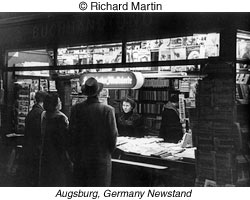
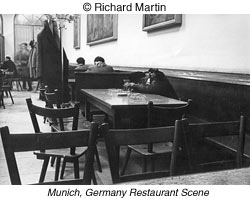
Jump ahead to the present day. Color is now the norm both in magazines and newspapers. Black & white has not disappeared, in spite of predictions of its demise when color became practical, but magazines are virtually all color nowadays. Newspapers still use black & white, mostly on the inside pages, but color is more and more in evidence. Economics does play a role, though. Small publications like weekly newspapers often cannot afford the cost of color.
But what about available light color? Is it now feasible? Yes indeed! We now have fast color films but the real news for available light can be expressed with one word: digital. Well, actually two words: digital and RAW. But first let's examine available light work with present-day film, especially color negative. Why color negative? Because you have more flexibility in correcting color balance and exposure (at least, overexposure) than you do with reversal (slide) film. Color negative has more exposure latitude. True, you can scan slides into the computer and adjust these things with Photoshop but there are definite limitations. Slide film does not render high-contrast subjects very well or tolerate overexposure. Yes, you can select those areas in Photoshop and make them darker but the detail in blown highlights is gone forever. The usual approach is to expose around the highlights and let the shadows fall where they may. As for color corrections, that too can be done in Photoshop (especially if it's a "high-bit" scan) but only if a digital file is what you want as the final product. Of course, you could have that digital file made into a slide (some labs offer this service) but the result will never approach the quality of the original slide.
For these reasons, available light presents particular challenges when shooting slide film. So why would you choose that type of film for this? Well, if you are submitting film images as opposed to digital, magazines usually prefer slides (or larger transparencies) for reproduction reasons and most won't accept color prints. Don't even think about sending them a negative! With slides you have an original that's a positive image. You can see right away what you have captured. What this means, in a nutshell, is you must get it right in the camera. And that means truly understanding the medium and its limitations and that takes time and experience. Slide film is very unforgiving. On the plus side, however, film in general (even slide film) still handles low-light subjects better than most digital cameras and low light is what available light is all about. But that situation is changing and a major reason is RAW.
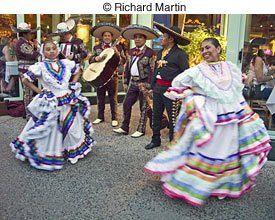
I discussed RAW in the context of point-and-shoot cameras in a previous article and the points I made are quite relevant when it comes to available light. Shooting under the latter typically requires a high ISO setting, (the color images here were shot at 400 ISO) in order to compensate for the low illumination and the small apertures of most zoom lenses. That means noise and that noise will be most noticeable in dark areas of the image. RAW gives you more control over noise reduction.
Color balance (white balance) is another issue that can best be handled by shooting RAW because you have more adjustment options, especially with Photoshop CS2. Color casts (incorrect color) are a common problem with available light and are sometimes even more difficult to fix due to light coming from various sources, each with a different color temperature. We can't select particular parts of the image in the RAW converter to adjust so in this latter case, the tools in Photoshop proper come into play. But shooting RAW means we have a high-bit file to play with and this gives us more control over the color.

Exposure is another area where RAW excels. In the main or Adjust tab for the Photoshop CS2 RAW converter, you have separate sliders to correct the highlights, shadows, and midtones. That does not mean you can just ignore exposure when you shoot. Gross underexposure will still result in a horrible image with lots of noise while with gross overexposure you can say bye-bye to detail. It does mean you can "tweak" the exposure and correct your initial capture. Plus you keep the original capture in case you change your mind and decide to do it differently later.
High contrast is often a big problem with available light and this presents special challenges for either slide film or digital capture. Typically, corrections require more than one tool. In Photoshop, opening an Adjustment Layer in Curves is the classic approach but you can also reduce contrast in the RAW converter by adjusting the Exposure, Shadows, Brightness, and Contrast sliders. But there's another way you might reduce contrast and it has nothing to do with Photoshop or any image editor. If your digital camera does not offer RAW capture but it does give you the option of adjusting the contrast parameters, just set some negative value. I routinely have contrast set for -2 in both of my digital cameras for those situations when I shoot JPEGs. By the way, Photoshop CS2 has a great new Shadow/Highlight tool. Click on the Show More Options box and you can then really fine-tune those adjustments.
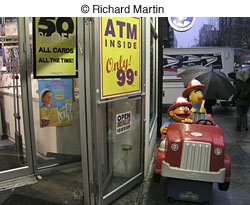
But suppose you would rather stick with more traditional materials such as black & white film and the "wet" darkroom. That's fine because film is still around and so is the processing chemistry. However, let's take this a step further and assume you want to mimic the available light "look" of an earlier era. Perhaps you've been inspired by work by W. Eugene Smith, Henri Cartier-Bresson, and others. Well, the "look" was considered natural and realistic, partly because flash was not used and partly because the images were sort of captured on the fly. In other words, it was candid photography – unposed and often without the subject being aware they were being photographed. The expression "the decisive moment", made popular by Cartier-Bresson, was the goal of photographers everywhere and it's just as relevant today as it was in his time. Some people take this "mimicry" a step further, though, and try to add graininess to the photo. Grain, in some quarters, has become an artistic statement. I've always found this particular conceit to be rather amusing. Why? Because we "old-timers" did everything we could to REDUCE grain, not accentuate it. Graininess was a defect, like dust marks on the print, and editors hated it. Our films were grainy because that was the state of the technology at the time, not because we wanted them to be grainy. Fine-grain, "compensating" developers like Microphen, Microdol-X, and my all-time favorite, Promicrol, did the trick in reducing grain in those days and many of us had our own little secrets involving various mixtures and dilutions. Grain didn't disappear but it became less obvious.
Shooting under available light is certainly challenging but don't let that deter you. When all the elements (you the photographer, your camera, and the processing) fall into place, the rewards are great. The bottom line is simply this – choose the tools you are most comfortable with. It doesn't matter whether it's film or digital. What counts is the resulting image.


